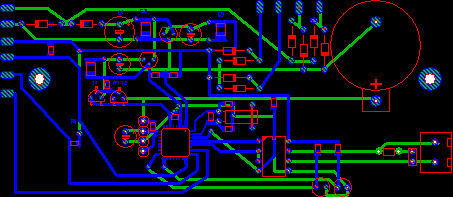A simple point-to-point autorouter is integrated
in Sprint-Layout. This autorouter is able to
connect two points of your layout. These two points are defined with a
connection (rubberband). The autorouter was not
designed, to generate whole boards at once.
This is usually not possible. To create a proper layout, you have to design it
mostly by yourself.
The autorouter in Sprint-Layout is designed as an
easy-to-use autorouter. You don't have to set
obscure specifications and options. The autorouter is as simple as the
whole software itself.
To use the autorouter, select the corresponding
button in the left toolbar:
A small tool-window appears with the available options for the autorouter:
Width:
Here you can select the width of the track, the
autorouter will use.
Distance:
Here you can define the minimal distance between
the track and the other elements.
Autorouting a connection
You can select the desired connection with the
mouse. If you move the mouse over a connection, the connection
will be light up. With a simple click you can now "autoroute" this connection.
The autorouted track will be placed on the active
layer. Make sure that the correct layer is
activated.
The autorouter is searching for the shortest way
to place the track. It takes care of the
minimal distance between the elements on his way:
- Elements on the active layer
- Drill-holes
If the autorouter finds a way, the track will be
created. Otherwise you will get a message in
the tool-windows.
Autoroutes are indicated by an inner stripe. So
you can distinguish between autorouted tracks
and normal tracks.
Resolving an autoroute
You can resolve an autorouted track back to a
connection. Just click on the autoroute, and
you will get the original connection.
Edit an autoroute
You can also edit the autorouted track just like
a normal track. You can adjust the width, move
the corners, etc.
Tips for using the autorouter
If you have many connections to route, start to
autoroute the shortest and easiest connections
first. You may realize, that one autoroute is "blocking" some other good
routes for other connections. Just resolve this
autoroute and try the other connections first.
Play with the sequence of the connections, to get the best results.
The autorouter can more likely find a route if
you select a small track-width and a small
distance. Try to change these values, if the autorouter fails to route a
connection. Anyway you can edit autorouted
tracks, if necessary.



No comments:
Post a Comment